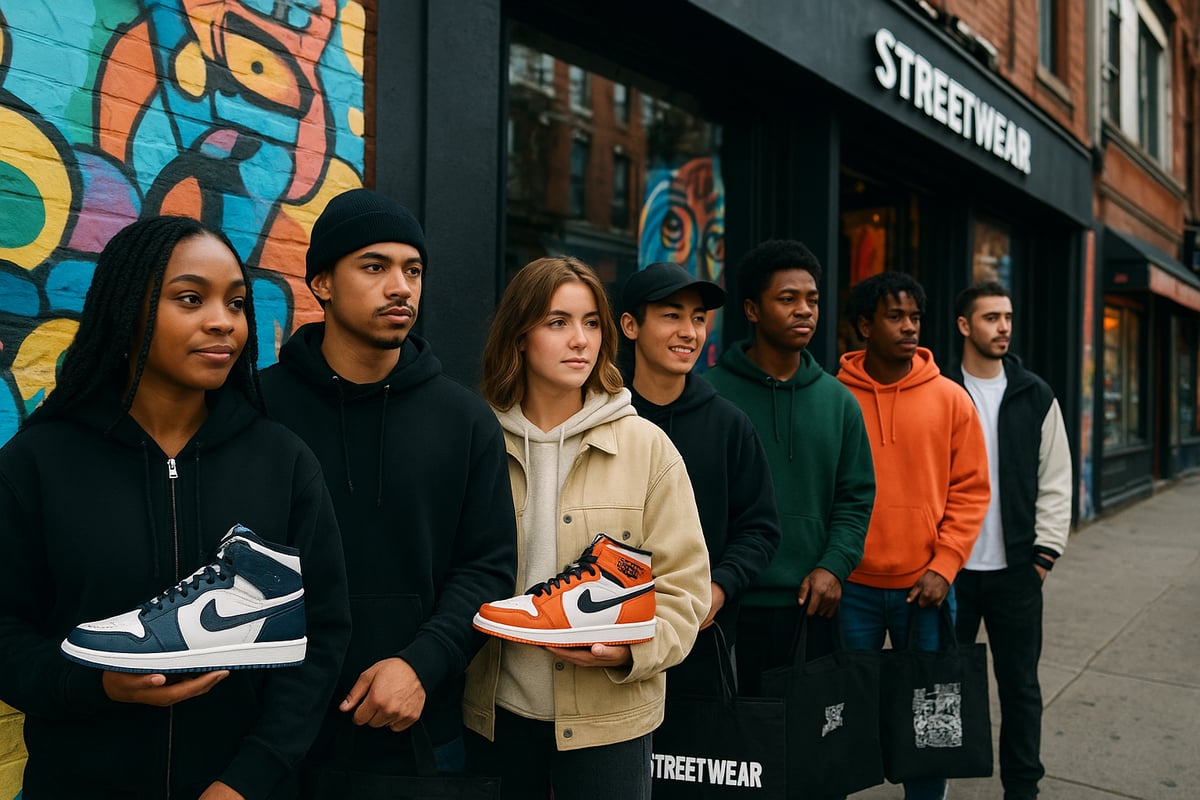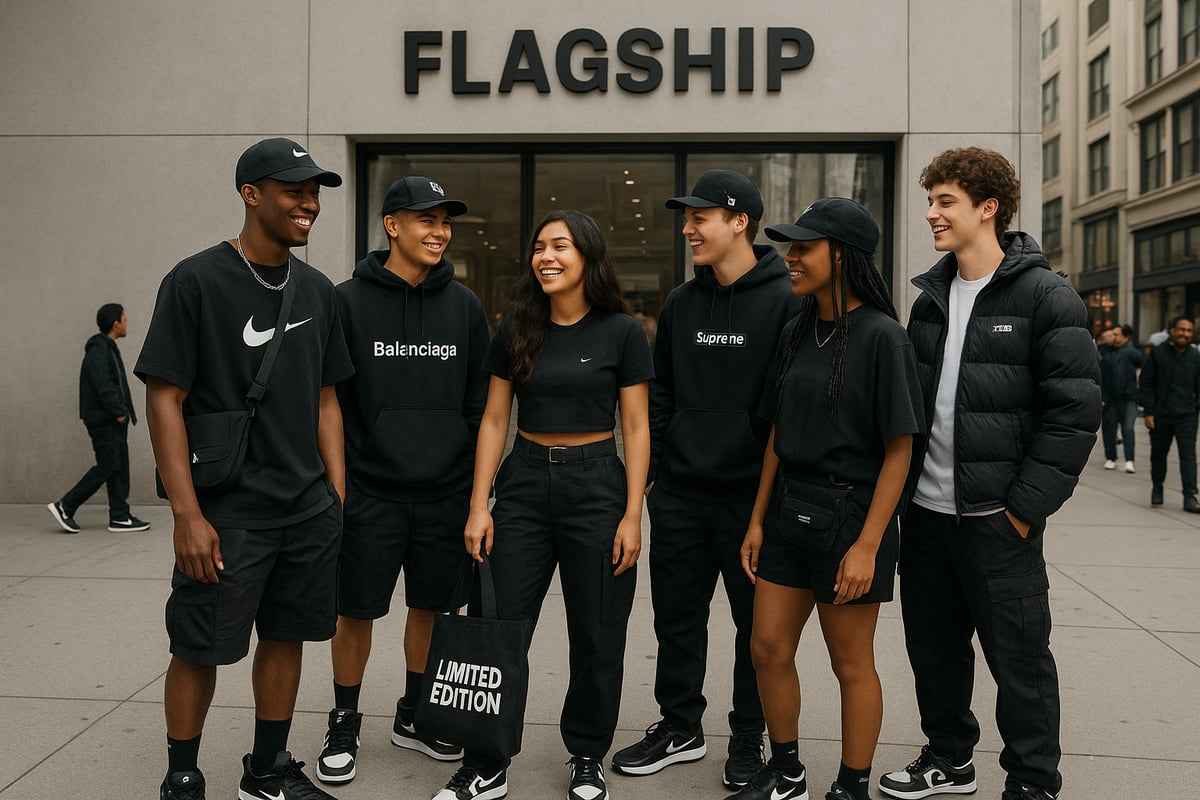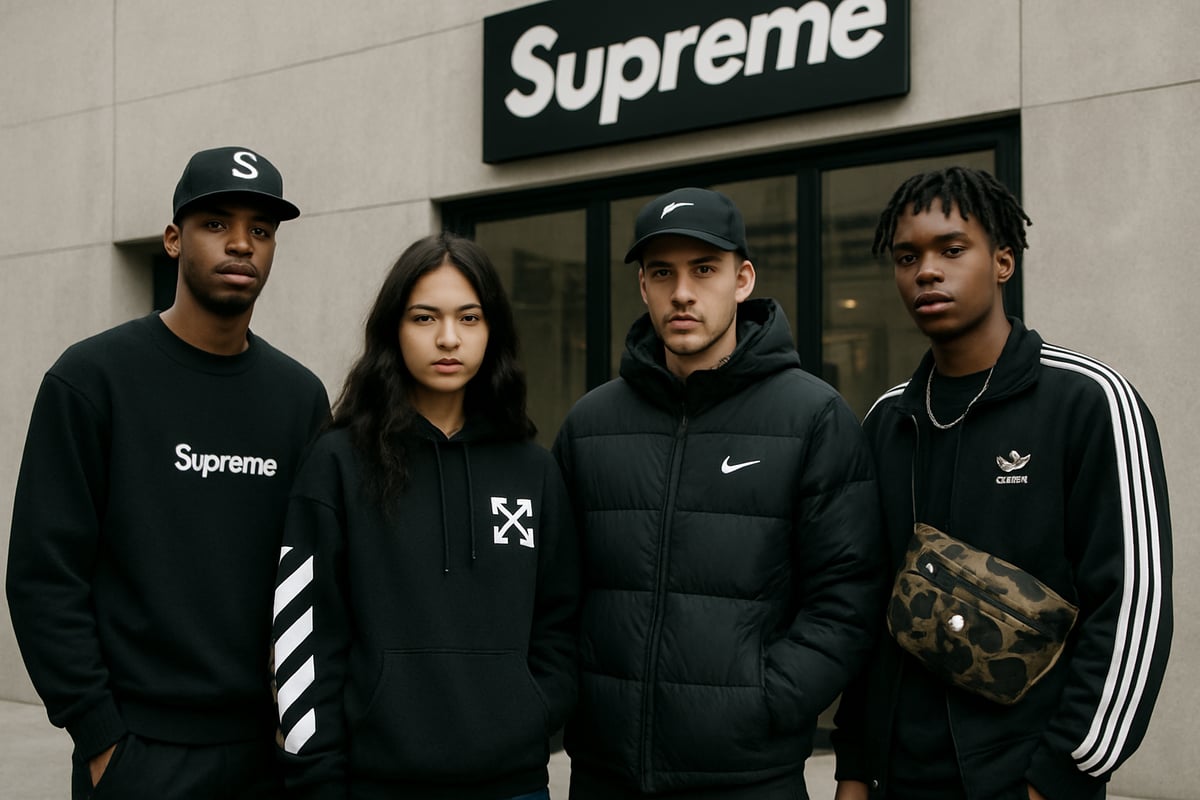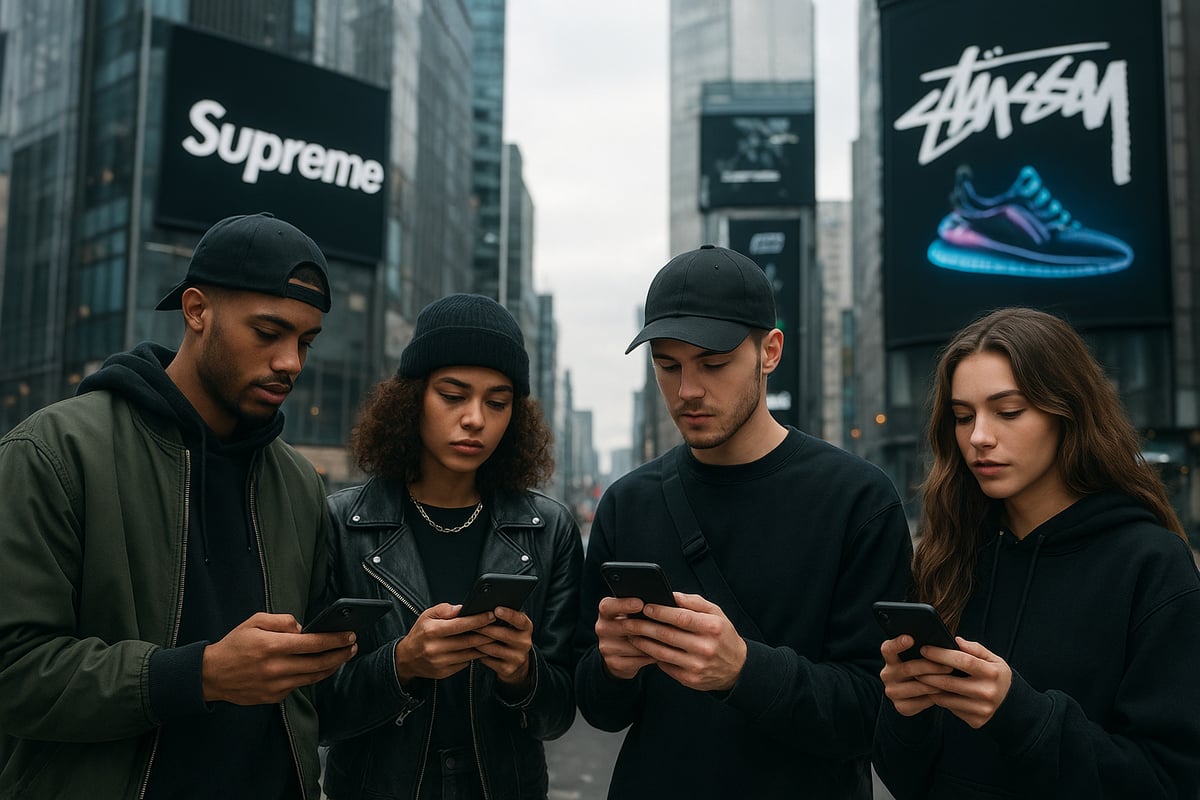The explosive growth of hypebeast culture has reshaped the fashion landscape in 2025, captivating youth and driving trends worldwide. From exclusive sneaker drops to viral collaborations, hypebeast culture now dominates social media feeds and global fashion conversations.
This article is your insider guide to the psychology, economics, and cultural forces powering today’s hypebeast scene. Explore how it began, the values that drive it, the brands making headlines, and the debates shaping its future. Ready to understand, join, or critique the movement? Dive in as we break down origins, values, brands, social media’s influence, controversies, and how to authentically engage with hypebeast culture in 2025.
The Origins and Evolution of Hypebeast Culture
The journey of hypebeast culture is a compelling tale of rebellion, innovation, and transformation. What began as a fringe movement in the early 2000s has become a global force shaping the very fabric of modern fashion. To truly understand the hypebeast phenomenon in 2025, we must trace its roots, examine its pivotal moments, and explore the new influences driving its evolution today.

The Birth of Hypebeast: From Subculture to Mainstream
Hypebeast culture emerged from the intersections of streetwear, sneakerhead communities, and youth counterculture in the early 2000s. Brands like Supreme and BAPE played a pivotal role, offering limited releases that quickly became must-haves among enthusiasts. These early drops, especially Supreme’s iconic lineups in New York, created a ritualistic sense of anticipation and exclusivity.
The influence of hip-hop, skateboarding, and youth rebellion was unmistakable. Artists and skaters pushed boundaries, adopting bold styles and championing individuality. Early online forums and niche blogs amplified this energy, allowing hypebeast culture to spread beyond city limits.
As the streetwear market began to grow, so did its influence. According to industry data, streetwear’s market share has expanded dramatically since 2010, signaling the shift from underground movement to mainstream powerhouse. Hypebeast culture was no longer just a local phenomenon—it was a global language of style.
Key Milestones: 2010-2025
The last decade and a half marked a series of transformative shifts for hypebeast culture. Major brand collaborations, such as Supreme x Louis Vuitton and Nike x Off-White, redefined the boundaries between luxury and streetwear. These partnerships generated immense buzz and set new standards for exclusivity.
A few key milestones include:
- The explosive growth of influencer marketing and celebrity endorsements.
- The dominance of social media platforms, especially Instagram and TikTok, in spreading trends.
- The rise of limited-edition drops and a thriving resale market.
- The globalization of hypebeast trends, with rapid expansion into Asia and Europe.
Instagram alone boasts over 150 million users under 35, making it a crucial driver for hypebeast culture’s reach and influence. High-profile sneaker releases now sell out in seconds, fueling both excitement and frustration in the community.
A quick comparison of key milestones:
| Year | Milestone | Impact |
|---|---|---|
| 2010 | Supreme x Nike SB Dunk Release | Established hype-driven collaborations |
| 2017 | Supreme x Louis Vuitton Collaboration | Luxury and streetwear merge |
| 2020 | Resale Market Exceeds $2 Billion | Resale becomes central to hypebeast culture |
| 2025 | Digital Fashion and NFTs Go Mainstream | Virtual items reflect status and exclusivity |
For a deeper analysis of how consumer habits and brand dynamics have shaped hypebeast culture, the Streetwear Impact Report by Hypebeast and PwC's Strategy& provides comprehensive insights.
The New Wave: Hypebeast Culture in 2025
In 2025, hypebeast culture is defined by a new set of values. Exclusivity and status remain central, but digital identity is now just as important. The emergence of digital fashion and NFTs has opened new avenues for self-expression, with virtual sneakers and apparel becoming coveted status symbols.
Luxury, sportswear, and streetwear aesthetics have fully blended, creating hybrid styles that dominate both physical and digital spaces. Tech brands are now collaborating with streetwear labels, pushing innovation even further. At the same time, sustainability and ethical production are becoming priorities, as consumers demand more transparency from their favorite brands.
The global streetwear market continues to grow, with projections for 2025 indicating an even stronger influence on mainstream fashion. Hypebeast culture is no longer just about what you wear—it is about how you engage, express, and connect in a rapidly evolving world.
Core Values and Psychology of Hypebeast Culture
Understanding the core values and psychology of hypebeast culture reveals why it resonates with so many in 2025. This section explores what motivates enthusiasts, how community shapes identity, and the paradoxes at the heart of the movement.

The Pursuit of Exclusivity and Status
At its core, hypebeast culture thrives on exclusivity. Limited product releases, known as "drops," create intense anticipation and a sense of urgency. For many, the act of lining up outside stores or waiting online for hours is a ritual that brings excitement and a shot at rare pieces.
Owning a coveted item is more than a personal achievement—it is a social signal. The higher the resale value, the more status it confers within the community. According to recent reports, limited-edition sneakers and apparel can fetch several times their retail price on the resale market. This pursuit of rarity fuels competition and drives the hypebeast culture forward.
For those interested in the psychological forces behind these trends, the Streetwear and Hypebeast Trends blog provides deeper insights into the behaviors and rituals that define the scene. Whether it is the adrenaline rush of a successful drop or the satisfaction of owning something few others have, exclusivity remains a central pillar of hypebeast culture.
Community, Identity, and Belonging
Hypebeast culture is not just about products—it is about belonging to a tribe. For many, wearing the latest drop is a form of self-expression and a badge of membership in a global community. Social media groups, online forums, and real-world meetups foster connections that transcend geography.
Flagship store launches often turn into social events, with fans traveling significant distances to be part of the action. These gatherings are more than just shopping trips—they are pilgrimages that reinforce the sense of unity and shared identity. Within these spaces, newcomers find mentors, share tips, and build lasting friendships.
This sense of belonging keeps hypebeast culture vibrant. It transforms fashion from a solitary pursuit into a collective experience, where style becomes a language and participation signals inclusion.
The Power of Branding and Perception
Branding is a powerful force within hypebeast culture. Logos are not just design elements—they are emblems of status and belonging. The psychological impact of owning a Supreme box logo T-shirt, for example, goes far beyond fabric and print. It is about being recognized as part of an exclusive club.
Perception often outweighs actual product quality. Many enthusiasts admit they are drawn to the story and hype surrounding a brand as much as the item itself. This dynamic is reflected in the vast difference between retail and resale prices for hyped products.
A well-placed logo or a limited collaboration can instantly elevate an item’s desirability. For many, the allure lies in the perception of uniqueness that these brands cultivate, which is a cornerstone of hypebeast culture.
The Critique: Individuality vs. Conformity
Despite its emphasis on self-expression, hypebeast culture faces criticism for promoting conformity. Some argue that by chasing the same brands and styles, enthusiasts risk becoming brand billboards rather than individuals. The desire to stand out paradoxically leads many to dress alike.
Social pressure to own certain items can be intense, especially among younger fans. Critics point out that this herd mentality can stifle creativity and authentic self-expression. The debate continues: does hypebeast culture empower individuals to express themselves, or does it encourage mass conformity?
Ultimately, the tension between individuality and group identity is part of what makes hypebeast culture both fascinating and controversial. It challenges participants to find a balance between following trends and forging their own path.
Major Brands, Collaborations, and Icons of 2025
In 2025, hypebeast culture stands at the intersection of innovation, exclusivity, and global influence. The brands, collaborations, and personalities shaping this landscape have redefined what it means to participate in streetwear. Let us explore the titans, luxury crossovers, emerging labels, the booming resale market, and the icons leading hypebeast culture forward.

The Titans: Supreme, Off-White, Nike, Adidas, and BAPE
Supreme, Off-White, Nike, Adidas, and BAPE continue to serve as the backbone of hypebeast culture in 2025. Each brand has evolved its signature style while maintaining its core identity. Supreme remains synonymous with bold graphics and limited drops. Off-White, under the late Virgil Abloh's creative direction, is celebrated for its industrial designs and high-profile collaborations.
Nike and Adidas dominate the sneaker landscape, pushing boundaries with innovative materials and design. BAPE, with its signature camo and shark motifs, holds its place as a symbol of streetwear authenticity.
Notable collaborations this year include Supreme x Nike's updated Air Force 1, Off-White x Air Jordan's futuristic reimagining, and Adidas teaming up with local artists for region-specific releases.
| Brand | Signature Style | Notable 2025 Collaboration | Avg. Resale Value Increase |
|---|---|---|---|
| Supreme | Bold graphics, minimal | Supreme x Nike Air Force 1 | 45% |
| Off-White | Industrial, deconstructed | Off-White x Air Jordan | 60% |
| Nike | Innovative sneakers | Nike x Sacai | 30% |
| Adidas | Performance & lifestyle | Adidas x Human Made | 25% |
| BAPE | Camo, shark hoodie | BAPE x Razer | 20% |
These brands fuel the heartbeat of hypebeast culture, setting the pace for trends and the secondary market alike.
The Luxury Streetwear Crossover
Luxury fashion houses have fully embraced hypebeast culture, blending couture with streetwear. Louis Vuitton, Gucci, and Balenciaga have all launched collections that fuse high fashion aesthetics with street-inspired silhouettes.
Louis Vuitton's ongoing collaborations with street artists and Supreme's legacy partnership have blurred the line between luxury and streetwear. Gucci's streetwear-inspired capsule collections have led to increased demand and higher retail prices. Balenciaga's oversized hoodies and sneakers have become staples among hypebeast enthusiasts.
The impact of these crossovers is significant. The average price of luxury streetwear collaborations has risen by 35 percent in the past year. These partnerships elevate hypebeast culture by merging exclusivity with luxury craftsmanship, appealing to collectors and fashion-forward consumers alike.
The Rise of New Players and Indie Labels
2025 has seen a surge in indie designers and local labels redefining hypebeast culture. These emerging brands bring fresh perspectives, often focusing on sustainability, small-batch production, and unique storytelling.
Notable new players include brands like Ader Error, Kidsuper, and local collectives from Seoul, Paris, and New York. Their collections often feature hand-painted graphics, upcycled materials, and artist-driven collaborations.
Indie labels challenge the dominance of established giants by prioritizing individuality and creative freedom. This shift encourages hypebeast culture participants to seek out lesser-known brands, supporting a more diverse and inclusive fashion ecosystem.
The Role of Resale Platforms and Marketplaces
Resale platforms are integral to the economics of hypebeast culture. Platforms like StockX, GOAT, and Grailed have transformed how enthusiasts buy, sell, and value limited-edition items. These marketplaces fuel demand by providing instant access to rare drops, often at significantly marked-up prices.
The sneaker and streetwear resale market is estimated to exceed $10 billion globally in 2025. Record-breaking sales, such as exclusive Yeezy releases or Travis Scott collaborations, continue to make headlines. The New York City resale scene, in particular, has a profound impact, as detailed in How NYC's Resale Market Fuels Hypebeast Trends.
Resale platforms also contribute to the culture's sense of urgency and scarcity, reinforcing the chase for exclusivity that defines hypebeast culture.
Icons and Influencers Shaping the Culture
Influential figures are at the core of hypebeast culture's evolution. Designers like Virgil Abloh and Nigo, artists such as Travis Scott, and a new generation of TikTok and Instagram personalities drive trends and shape perceptions.
These icons have global reach, often turning a single product or collaboration into an overnight sensation. Their endorsements, style choices, and social media presence create ripple effects throughout the community.
Emerging influencers from Asia and Europe are also gaining traction, reflecting the worldwide expansion of hypebeast culture. Their creativity and unique perspectives ensure that the culture remains dynamic, continually evolving in response to new voices and ideas.
The Role of Social Media, Technology, and Digital Hype in 2025
In 2025, social media and technology have become the lifeblood of hypebeast culture. The way trends emerge, spread, and fade is shaped by digital platforms, algorithms, and the relentless pace of online engagement. Exploring these forces reveals how hypebeast culture thrives not just in physical spaces, but also across a constantly evolving digital landscape.

Instagram, TikTok, and the Hypebeast Ecosystem
Social media platforms like Instagram and TikTok are the primary stage for hypebeast culture in 2025. These apps are where new looks go viral, exclusive drops are teased, and communities gather to celebrate the latest trends. The power of a single fit pic or unboxing video can catapult a brand or product into the global spotlight within minutes.
Instagram’s Explore page is a key driver, surfacing emerging styles and connecting users with influencers who define hypebeast culture. According to competitor data, HYPEBEAST Magazine boasts 5.4 million Instagram followers, most under 35. Viral challenges and hashtag trends make it easy for anyone to join the conversation and showcase their style.
TikTok’s short-form videos amplify this effect, turning sneaker unboxings and streetwear hauls into must-see content. These platforms do not just reflect hypebeast culture, they actively shape it, as highlighted in The Influence of Social Media. Communities form around exclusive drops, and the fastest thumbs often win the rarest prizes.
The Algorithm and the Hype Cycle
Behind the scenes, powerful algorithms drive the rapid rise and fall of trends within hypebeast culture. Social media feeds are tailored to highlight what is new and popular, pushing limited releases and collaborations to the top of users’ screens. As a result, the hype cycle has accelerated, with microtrends emerging and fading in weeks rather than months.
Timing is everything. Brands carefully plan their announcements and product drops to maximize engagement and capitalize on algorithmic boosts. The speed at which new styles go viral is unmatched, creating a sense of urgency that keeps followers constantly checking for updates. For hypebeast culture, the algorithm is both a gatekeeper and a megaphone, shaping what becomes the next must-have item.
Digital Fashion, NFTs, and Virtual Collectibles
The digital revolution has introduced new forms of status within hypebeast culture. In 2025, digital-only fashion and NFTs are as coveted as physical sneakers or apparel. Virtual collectibles, such as NFT sneakers and exclusive digital wearables, offer fans a new way to express identity and gain social capital in online spaces.
Recent NFT sneaker launches have sold out in seconds, with some digital items fetching prices comparable to their real-life counterparts. The market value of digital fashion continues to grow, with projections for 2025 indicating a substantial increase in both participation and spending. For many enthusiasts, owning a rare virtual collectible is now a core part of their hypebeast culture experience.
| Digital Asset Type | Example | 2025 Market Value Estimate |
|---|---|---|
| NFT Sneakers | Virtual Air Jordans | $400M+ |
| Digital Wearables | VR streetwear | $250M+ |
| Limited Edition Avatars | Designer collabs | $100M+ |
The Dark Side: FOMO, Mental Health, and Fake Flexing
While technology and social media fuel creativity and connection, they also introduce challenges for those immersed in hypebeast culture. The constant stream of new drops and exclusive releases can create intense FOMO, especially among younger fans. The pressure to keep up with trends can impact mental health, leading to stress, anxiety, and even financial strain.
Fake flexing, where individuals showcase counterfeit or borrowed items to appear trendy, is increasingly common online. Stories of social media burnout are not unusual, as users struggle to maintain a curated image. Counterfeit products further complicate the scene, making authenticity harder to discern. Navigating these challenges is now an essential skill for anyone involved in hypebeast culture.
Criticisms, Controversies, and the Debate on Authenticity
The rapid ascent of hypebeast culture has sparked passionate debates about its true impact. While it has energized fashion, it has also come under scrutiny for its financial demands, conformity, and environmental footprint. Below, we explore the most pressing controversies shaping the conversation in 2025.
The High Cost of Hype: Financial and Social Critiques
The financial barriers to entry in hypebeast culture are higher than ever. Limited releases and exclusive drops often sell out instantly, only to reappear on resale platforms at double or triple the original price. For example, a Supreme T-shirt might retail for $50 but resell for $500, making participation costly for young fans.
This financial strain raises questions about accessibility and inclusivity. Many critics argue that hypebeast culture prioritizes profit over genuine appreciation for style and creativity. The focus on high resale values and status symbols can foster unhealthy competition and even drive some enthusiasts into debt.
Recent financial reports, such as the Hypebeast Ltd. 2025 Year-End Financial Results, highlight the massive revenue generated by hype-driven brands. This data underscores the economic power of hypebeast culture and fuels debates about whether the movement serves consumers or exploits them.
Individuality vs. Mass Conformity
Hypebeast culture claims to celebrate self-expression, yet critics often point to a paradox. Many participants strive to stand out, but end up wearing the same limited-edition pieces as everyone else. Schools and social spaces sometimes become arenas for brand competition, where not having the latest drop can feel isolating.
This tension between individuality and conformity is at the heart of ongoing debates. Some argue that hypebeast culture stifles creativity by encouraging people to follow trends rather than set them. The pressure to keep up with new releases can make true self-expression difficult, causing many to question the authenticity of the movement.
Despite these criticisms, others believe that hypebeast culture offers a sense of belonging and community. By participating in shared rituals and styles, individuals can connect with like-minded peers, even if their choices sometimes appear uniform.
Sustainability, Ethics, and Fast Fashion
The environmental impact of hypebeast culture is another major concern. The constant churn of exclusive drops and fast fashion cycles leads to overconsumption and waste. Many limited releases are produced in small quantities, but the demand for novelty encourages frequent purchases and rapid turnover.
Environmental advocates criticize brands that do not prioritize sustainability or ethical production. The carbon footprint of manufacturing, shipping, and packaging exclusive items adds up quickly. However, some brands are taking steps to address these issues, using recycled materials and transparent sourcing.
For those interested in how exclusive launches drive these cycles, browsing Exclusive Drops and Limited Releases provides insight into the frequency and scale of new collections. The hope is that as hypebeast culture evolves, both consumers and brands will push for more responsible practices.
The Future of Authenticity: Where Does Hype Go Next?
Looking ahead, the debate over authenticity in hypebeast culture shows no signs of fading. Will the movement embrace more genuine self-expression, or will it continue to revolve around status and conformity?
Some predict a shift as younger generations demand transparency, sustainability, and creativity from the brands they support. Others argue that the allure of exclusivity will remain central, even as the culture adapts to new challenges. Only time will tell if hypebeast culture can redefine itself or if the same controversies will persist.
How to Authentically Engage with Hypebeast Culture in 2025
Authentically engaging with hypebeast culture in 2025 is about more than simply following trends. It requires a thoughtful approach to style, community, and values. Whether you are a newcomer or a seasoned enthusiast, the following strategies will help you find your place while staying true to yourself.
Building Your Own Style Within the Hype
Personal style is the foundation of authentic engagement with hypebeast culture. Instead of turning into a walking advertisement for big brands, blend hyped pieces with unique elements that reflect your identity. Look for up-and-coming labels and limited runs to add distinctive touches.
Experiment by mixing high-profile collaborations with vintage items or lesser-known designers. This approach not only sets you apart but also demonstrates a deeper appreciation for fashion’s creative side. For inspiration, explore Emerging Hypebeast Brands to discover fresh pieces that can elevate your wardrobe beyond the mainstream.
Fashion influencers often combine exclusive drops with thrifted finds, proving that true style is about curation, not just consumption. By doing so, you can participate in hypebeast culture while expressing individuality.
Navigating Drops, Resale, and Community
The heart of hypebeast culture beats during exclusive drops and in tight-knit communities. To secure limited releases, research drop calendars, join online forums, and follow trusted resellers. Always verify authenticity when buying or selling, and use reputable platforms to avoid scams.
Offline, participate in local meetups or flagship store events to connect with fellow enthusiasts. Be respectful and supportive within the community, as relationships and reputation matter as much as the products themselves.
Remember, hypebeast culture thrives on shared passion and mutual respect. Engaging thoughtfully helps you avoid common pitfalls and enhances your overall experience.
Social Responsibility and Conscious Consumption
Mindful participation in hypebeast culture means making ethical and sustainable choices. Prioritize brands committed to transparency and eco-friendly practices. Research where and how products are made before purchasing.
The digital shift in fashion, including NFTs and virtual wearables, is also shaping consumption patterns. To understand how innovation is influencing sustainability, see the Fashion Industry in the Age of Generative AI and Metaverse. Supporting responsible brands not only benefits the planet but also sets a positive example for the community.
Conscious consumption is about quality over quantity, ensuring your involvement in hypebeast culture aligns with your values.
Embracing Creativity and True Self-Expression
At its core, hypebeast culture is a canvas for creativity and self-expression. Use it to tell your story, not just to signal status. Take inspiration from individuals who reinterpret trends, mix unexpected pieces, or design their own clothing.
By prioritizing creativity, you help redefine what it means to belong to hypebeast culture. Let your style speak for you, and encourage others to do the same. Authenticity always stands out in a sea of imitation.
As you’ve seen, hypebeast culture in 2025 is all about pushing boundaries, embracing individuality, and finding your own voice in the world of fashion. If you’re ready to express your creativity and step confidently into styles that reject conformity, why not take the next step? Explore designs that capture the “fuck it” spirit and celebrate authentic self-expression—just like Oliver Wilcox did when he started Maybe Today NYC. You don’t have to wait for permission to stand out.
Explore the Collection

0 comments